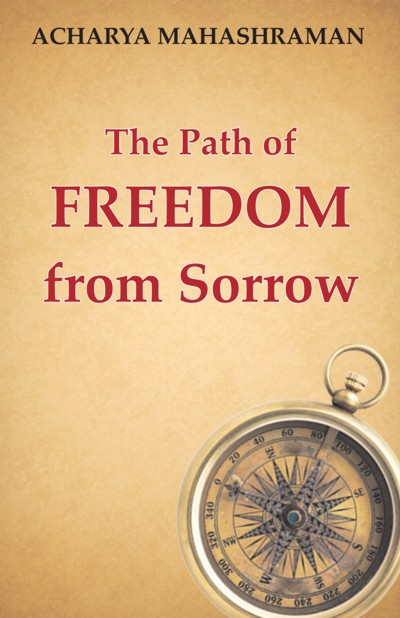A beautiful word found in the Jain Agam is 'thiyappa' (sthitatma) and another word is 'veeyarag' (veetarag). 'sthitatma' (equable) and 'veetarag' (detached) both souls seem like on the same level of purity. The word 'sthitapragya' is found in the 'Shrimad-bhagavad Gita' also. This word is analogous to the above mentioned two words. The soul with the attribute of 'veetrag' or 'sthitatma' is 'sthitapragya'.
As it is said in the Gita:
veetrag-bhayakrodhah sthitadhir-muniruchyate
There are three conditions for being sthitapragya. The person who is free from attachment, fear and anger, is sthitapragya. In one word, the equanimous soul is sthitapragya.
The life of a person is full of attachment. He is lured toward material possessions, enamoured by specific persons. Even in the religious sphere also a small amount of attachment exists. To become veetarag or sthitapragya, complete detachment is essential. The attachment of a disciple for his Guru also needs to be relinquished. The chief disciple of Bhagwan Mahaveer, Gandhar Gautam, was attached to him. Gandhar Gautam could not become omniscient, till he was attached.
Some amount of attachment is acceptable in the lay man's life, but there must be control over it. Materialistic enjoyment has its own significance in worldly life, but self- engrossment also must be taken care of. Control should go hand in hand with consumption. If there is control of detachment over attachment, control of self-engrossment over entertainment, control(self-restraint) of yog over consumption, then the life of a house holder can be peaceful to some extent.
The first condition of sthitpragya is development of detached consciousness. Sometimes even the eminent acharya also gets the feeling of attachment. It may be religious attachment or auspicious attachment but it is an impediment for veetaragata none the less. Therefore relinquishment of attachment is a must for veetaragta. Attachment or being enamoured can bring downfall or destruction. The fifth Acharya of the Terapanth order was Veetaragkalp Acharya Maghwa. History elucidates his serenity, detachment and greatness. Once a monk as per his pre-planning poured dust on him. He stood up, cleaned the dirt and re-engrossed in his work. His Guru Jayacharya asked 'Maghji! What happened?' Maghji replied, 'accidently, the dust had been fallen upon me by someone. There is always dust in storm. But it is ok.'Sthitapragya is the one who knows how to remain in equanimity.
The second parameter for sthitapragya is development of a fearless personality. Man feels fear. Sometimes he is so afraid that he becomes nervous even in normal situation.
There was a lean and thin man in Delhi. Once he said that he would get scared whenever he crossed the Yamuna Bridge. When he was asked for the reason behind this fear, he responded, 'What will happen to me if this bridge collapses?' Even though the heavy vehicles, which run over the bridge constantly do not make the bridge tumble down - how can a lean person make the bridge fall down? Possibly, he had intense fear inside. Similarly, many people are afraid of darkness. The imagination of ghosts in the mind makes people fearful. Man becomes afraid of violent animals. He has the fear of being insulted. It is his weakness. One should not become nervous in fearful situations. One should face them. Sometimes people become afraid of non-existent fear. Imaginary fear, without basis in reality, causes real world stress and negative repercussions.
To be free from fear one should deploy the support of proven methods and techniques. Chanting mantra is one kind of support. If a man with intense devotion prays to his adorable and chants his name as mantra then this mantra strengthens and supports his mind in fearful situations which consequently helps him to overcome the troubles. Many people live a stressful life just because of fear and they suffer mentally. In the presence of fear the practice of truth becomes difficult. A fearful person can tell lies and gets driven to commit violence also. To practice the truth and ahimsa it is necessary to practice fearlessness. There should be fear of nothing, neither for death, disease or any situation.
The third condition of sthitapragya is development of calm consciousness. He, who becomes free from anger, can become sthitapragya. In general, in unfavourable situations man becomes angry but he, who is habitually calm and forgiving does not get angry even in unfavourable situations and he accepts the situations with cool and happy mind.
Once, saint Ekanath was returning home after having his bath in the river Godavari. On his way a man spat on him. Saint Ekanath took his bath again. The person spat again. The sequence of incidents kept on going. Finally the person who was spitting got tired. He requested humbly, 'O saint! Please forgive me. I have misbehaved with you.' Saint replied, 'You spat at me over and over. That's why I got chance to take bath in the river Godavari time and again. Otherwise every day, I do just once. Why should I get angry? I am grateful to you.' Really it is very difficult to stay cool and not becoming angry in adversity. If we study the lives of great saints we find out how they practiced forgiveness and how much they bore their adverse situations.
He who becomes free from attachment, fear, and anger can become sthitapragya. These three words are almost similar veetrag or sthitatma in Jain literature and sthitapragya in the Gita. Through practice and faith a person can attain the state of veetrag or sthitpragya.
 Acharya Mahashraman
Acharya Mahashraman
